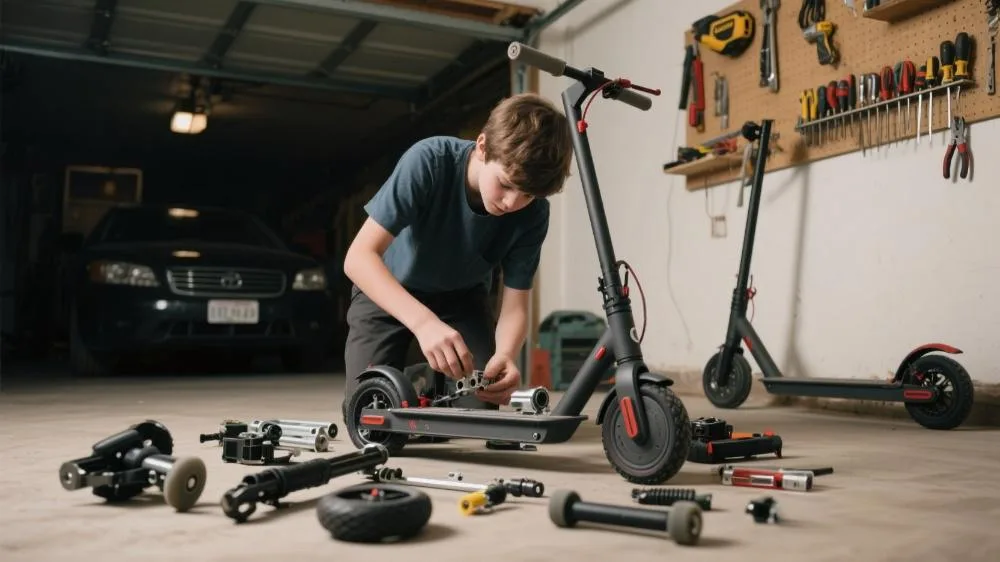how to make an electric scooter at home

How to make an electric scooter at home? The DIY electric vehicle movement is gaining momentum among tech enthusiasts across Western markets. According to the 2025 European DIY Transportation Association (EDITA) survey, approximately 28% of respondents have attempted building an electric scooter at home, with a 73% success rate. Data from specialist platform novascooter reveals that basic homemade e-scooter kits cost $300-500 – about 40% cheaper than entry-level commercial models.
Constructing an electric scooter requires integrating three core systems: the powertrain (motor and battery), control system (speed controller and circuitry), and mechanical structure (frame and wheels). MIT’s Department of Mechanical Engineering 2025 research confirms that modular design principles enable hobbyists to complete 85% of assembly in home workshops. Notably, current EU micromobility regulations mandate that homemade vehicles must not exceed 1000W power, remain under 25km/h top speed, and include basic lighting and braking systems.

Materials and Tools Preparation
Essential Components List
- Powertrain System
- Motor: Brushless hub motor (350-500W range)
- Battery: 36V10Ah lithium-ion pack (2025 models offer 800 charge cycles)
- Controller: ESC matching motor specifications
- Mechanical Structure
- Frame: Aluminum alloy or high-strength steel tubing
- Wheels: 8-10 inch pneumatic tires
- Brakes: Mechanical disc or drum systems
- Control Electronics
- Throttle: Twist or thumb-style controller
- Display: Basic speed/battery indicator
- Wiring: Waterproof power/signal cables
Required Tools
Basic Toolkit:
- Adjustable wrench set
- Phillips/flathead screwdrivers
- Wire cutters/strippers
- Digital multimeter
Specialty Tools (Optional):
- Spot welder (for battery assembly)
- 3D printer (custom plastic parts)
- Frame welding equipment
Safety Gear:
- Protective goggles
- Cut-resistant gloves
- Fire extinguisher (essential for lithium work)
Step-by-Step Assembly Guide
Frame Construction
- Base Frame Options
- Convert existing kick scooter (choose sturdy models)
- Full custom build (using 25mm aluminum square tubing)
- 3D printed frame (for experimental small-scale builds)
- Powertrain Installation
- Hub motor mounting (ensure perfect wheel alignment)
- Battery compartment design (low center of gravity)
- Controller placement (well-ventilated location)
- Ergonomic Adjustments
- Handlebar height (match rider’s stature)
- Deck positioning (natural standing posture)
- Folding mechanism (optional for storage)
Electrical System Wiring
Safe Connection Sequence:
- Main circuit: Battery→Controller→Motor
- Throttle signal wiring
- Brake cutoff system
- Lighting circuits (headlight/taillight/turn signals)
Critical Notes:
- Insulate all connection points
- Never reverse polarity
- Secure cables with zip ties
Testing Protocol:
- No-load power test (without wheels)
- Basic function check (throttle/brake response)
- Load testing (simulate rider weight)
Performance Tuning
Basic Parameter Setup
- Speed Limiting
- Configure legal limits via controller software
- Mode selection (eco/sport presets)
- GPS verification of actual speed
- Battery Management
- Charge voltage thresholds
- Discharge protection
- Temperature monitoring
- Power Delivery
- Acceleration curve adjustment
- Maximum output limitation
- Regenerative braking intensity
Road Testing Essentials
Safety Validation:
- Low-speed trials (5-10km/h in controlled areas)
- Mid-speed stability (15-20km/h)
- Braking distance (dry/wet conditions)
Performance Metrics:
- 0-20km/h acceleration
- Maximum climb angle
- Single-charge range
Troubleshooting:
- Motor noise → inspect bearings/gears
- Power loss → check wiring
- Battery overheating → improve cooling
Safety and Legal Compliance
Homemade Vehicle Certification
- European Standards
- EN17128:2025 for DIY vehicles
- Mandatory electrical safety tests
- 1000W power ceiling
- North American Rules
- UL2272 certification (some states)
- Speed limits (typically under 20mph)
- Lighting/reflector requirements
- Insurance Considerations
- Some providers exclude homemade vehicles
- Stricter accident liability
- Public road restrictions vary
Safe Operation Practices
Mandatory Equipment:
- ECE22.06 certified helmet
- Protective gloves/knee pads
- High-visibility vest
Maintenance Checklist:
- Monthly battery health checks
- Brake system wear inspection
- Fastener tightness verification
- Tire pressure and tread condition
Warning Signs:
- Abnormal battery heat
- Controller overheating
- Irregular motor operation
- Visible frame cracks
Advanced Modifications
Performance Enhancements
- Powertrain Upgrades
- Battery expansion (parallel configurations)
- Higher-wattage motors (500W+)
- Dual-motor AWD systems (advanced)
- Smart Features
- Mobile app connectivity
- GPS tracking/anti-theft
- Ride data analytics
- Specialized Builds
- Off-road (larger tires/suspension)
- Cargo (rear rack integration)
- Compact folding (space optimization)
Innovative Designs
2025 DIY Community Trends:
- Solar charging assist
- Modular battery swapping
- Regenerative braking optimization
- 3D printed lightweight components
Material Innovations:
- Carbon fiber composites
- Experimental graphene batteries
- Self-healing tire compounds
Safety Innovations:
- Crash auto-shutoff
- Blind spot detection
- Emergency brake assist
